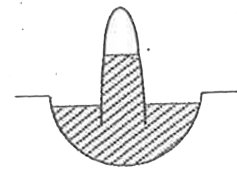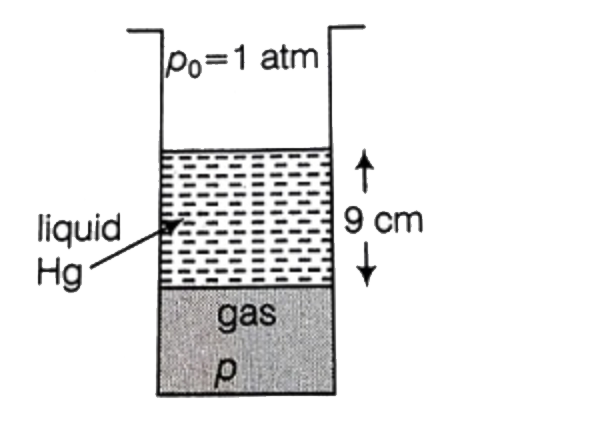At room temperature, ammonia gas at 1atm pressure and hydrogen chloride gas at Patm pressure are allowed to effuse through identical pin holes from opposite ends of a glass tube of 1m length and of uniform cross- section. Ammonium chloride is first formed at a distance of 60cm from the end through which HCl gas is sent in. What is the value of P?
To solve the problem, we will use Graham's law of effusion, which states that the rate of effusion of a gas is inversely proportional to the square root of its molar mass. The formula can be expressed as:
RHClRNH3=PHClPNH3⋅√MNH3MHCl
Where:
- RHCl and RNH3 are the rates of diffusion of HCl and NH3 respectively.
- PHCl and PNH3 are the pressures of HCl and NH3 respectively.
- MNH3 and MHCl are the molar masses of NH3 and HCl respectively.
Step 1: Identify the distances
Given that ammonium chloride is formed 60 cm from the HCl end, we can conclude:
- Distance traveled by HCl = 40 cm
- Distance traveled by NH3 = 60 cm
Step 2: Set up the ratio of rates of diffusion
Using the distances traveled by the gases, we can express the rates of diffusion:
RHClRNH3=6040=32
Step 3: Identify the pressures and molar masses
From the problem:
- PNH3=1atm
- Let PHCl=Patm
The molar masses are:
- MNH3=17g/mol
- MHCl=36.5g/mol
Step 4: Substitute into Graham's law
Substituting the known values into Graham's law:
32=P1⋅√1736.5
Step 5: Simplify the equation
First, calculate the square root:
√1736.5≈0.693
Now substitute this back into the equation:
32=P⋅0.693
Step 6: Solve for P
Now we can solve for P:
P=320.693≈2.165atm
Step 7: Final answer
Thus, the value of P is approximately 2.165atm.
- RHCl and RNH3 are the rates of diffusion of HCl and NH3 respectively.
- PHCl and PNH3 are the pressures of HCl and NH3 respectively.
- MNH3 and MHCl are the molar masses of NH3 and HCl respectively.
Given that ammonium chloride is formed 60 cm from the HCl end, we can conclude:
- Distance traveled by HCl = 40 cm
- Distance traveled by NH3 = 60 cm
Using the distances traveled by the gases, we can express the rates of diffusion:
RHClRNH3=6040=32
From the problem:
- PNH3=1atm
- Let PHCl=Patm
- MNH3=17g/mol
- MHCl=36.5g/mol
Substituting the known values into Graham's law:
32=P1⋅√1736.5
First, calculate the square root:
√1736.5≈0.693
Now substitute this back into the equation:
32=P⋅0.693
Now we can solve for P:
P=320.693≈2.165atm
Thus, the value of P is approximately 2.165atm.
Topper's Solved these Questions
- STATES OF MATTERBOOK - CENGAGE CHEMISTRY ENGLISHCHAPTER - STATES OF MATTEREXERCISE - Concept Application 5.3
1 Videos
- STATES OF MATTERBOOK - CENGAGE CHEMISTRY ENGLISHCHAPTER - STATES OF MATTEREXERCISE - Ex 5.4
32 Videos
- STATES OF MATTERBOOK - CENGAGE CHEMISTRY ENGLISHCHAPTER - STATES OF MATTEREXERCISE - Ex 5.2
16 Videos
- SOME BASIC CONCEPTS AND MOLE CONCEPTBOOK - CENGAGE CHEMISTRY ENGLISHCHAPTER - SOME BASIC CONCEPTS AND MOLE CONCEPTEXERCISE - Archives Subjective
11 Videos
- STOICHIOMETRYBOOK - CENGAGE CHEMISTRY ENGLISHCHAPTER - STOICHIOMETRYEXERCISE - Archives Subjective
33 Videos
Similar Questions
At room temperature, ammonia gas at 1 atm pressure and hydrogen chloride gas at P atm pressure are allowed to effuse through identical pin holes from opposite ends of a glass tube of one metre length and of uniform cross section. Ammonium chloride is first formed at a distance of 60 cm from the end through which HCl gas is sent in. What is the value of P?
View SolutionThrough the two ends of a glass tube of length 200cm hydrogen chloride gas and ammonia are allowed to enter At what distance ammonium chloride will first appear ? .
View SolutionX and Y are two volatile liquids with molar weights of 10gmol−1 and 40gmol−1 respectively. Two cotton plugs, one soaked in X and the other soaked in Y, are simultaneously placed at the ends of a tube of length L=24 cm, as shown in the figure.
The tube is filled with an inert gas at 1 atm pressure and a temperature of 300K. Vapours of X and Y react to form a product whichh is first observed at a distance dcm from the plug soaked in X.
Take X and Y to have equal molecular diameters and assume ideal behaviour for the inert gas and two vapours.

The value of d in cm (shown in figure), as estimated from Graham's law, is
View SolutionX and Y are two volatile liquids with molar weights of 10gmol−1 and 40gmol−1 respectively. Two cotton plugs, one soaked in X and the other soaked in Y, are simultaneously placed at the ends of a tube of length L=24 cm, as shown in the figure.
The tube is filled with an inert gas at 1 atm pressure and a temperature of 300K. Vapours of X and Y react to form a product whichh is first observed at a distance dcm from the plug soaked in X.
Take X and Y to have equal molecular diameters and assume ideal behaviour for the inert gas and two vapours.

The value of d in cm (shown in figure), as estimated from Graham's law, is
View SolutionTorricelli was the first do devise an experiment for measuring atmospheric pressure . He took calibrated hard glass tube , 1 m in lengt and of uniform cross section , closed at one end . He filled the whole tube with dry mercury taking care than no air or water droplets remain inside the tube , closed the opposite end of the tube tightly with thumb and inverted it . He put this inverted mercury tube into a mercury through , taking care that the end of the tube remains inside the mercury through , An interesting thing was noticed . Mercury in the tube fell down at first and then stopped at a particular position . The height was 76 cm above the free surface of mercury in the through . When the given tube was inclined or lowered in the mercury trough , the vertical haight of mercury level in the tube was always found constant .
Torricelli explained this by saying that the free surface of mercury in the trough . Hence , the hydrostatic pressure exerted by the trough measures the atmospheric pressure .
If an additional hole is also made at P ' at the top point of the tube , then

A. mercury will not come out of the tube
B. mercury may come out of the tube after some time .
C. mercury will come out of the tube instantly
D. none of these
View SolutionTorricelli was the first do devise an experiment for measuring atmospheric pressure . He took calibrated hard glass tube , 1 m in lengt and of uniform cross section , closed at one end . He filled the whole tube with dry mercury taking care than no air or water droplets remain inside the tube , closed the opposite end of the tube tightly with thumb and inverted it . He put this inverted mercury tube into a mercury through , taking care that the end of the tube remains inside the mercury through , An interesting thing was noticed . Mercury in the tube fell down at first and then stopped at a particular position . The height was 76 cm above the free surface of mercury in the through . When the given tube was inclined or lowered in the mercury trough , the vertical haight of mercury level in the tube was always found constant .
Torricelli explained this by saying that the free surface of mercury in the trough . Hence , the hydrostatic pressure exerted by the trough measures the atmospheric pressure .

If this expriment uses water instead of mercury , then
A. length of water will be equal to 76 cm
B. length of water will be less than 76 cm
C. length of water will be greater than 76 cm
D. none of the above
View SolutionTorricelli was the first do devise an experiment for measuring atmospheric pressure . He took calibrated hard glass tube , 1 m in lengt and of uniform cross section , closed at one end . He filled the whole tube with dry mercury taking care than no air or water droplets remain inside the tube , closed the opposite end of the tube tightly with thumb and inverted it . He put this inverted mercury tube into a mercury through , taking care that the end of the tube remains inside the mercury through , An interesting thing was noticed . Mercury in the tube fell down at first and then stopped at a particular position . The height was 76 cm above the free surface of mercury in the through . When the given tube was inclined or lowered in the mercury trough , the vertical haight of mercury level in the tube was always found constant .
Torricelli explained this by saying that the free surface of mrcury in the trough . Hence , the hydrostatic pressure exerted by the trough measures the atmospheric pressure .

If a small hole is made at point P in the barometer tube , then

View SolutionThe density of the vapour of a substance at 1 atm pressure and 500 K is 0.36 kg m−3. The vapour effuses through a small hole at a rate of 1.33 times faster than oxygen under the same condition.
Determine, (a) molecular weight (b) molar volume (c) compression factor (Z) of the vapour and (d) which forces among the gas molecules are dominating, the attractive or the repulsive?
View Solution16 mL of He gas effuses through a pin hole in 4 sec from a container having PHe equal to 1 atm. If same container is filled with CH4 having pressure 2 atm, how much volume (in mL) of CH4 will be leaked through same pin hole in 2 sec?
View SolutionIn the given figure, atmospheric pressure p0=1 atm and mercury column length is 9 cm. Pressure p of the gas enclosed in the tube is

View Solution
